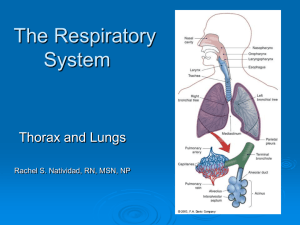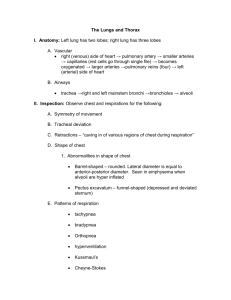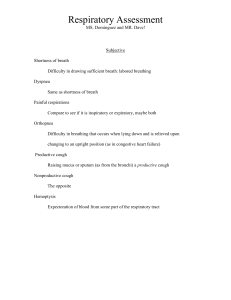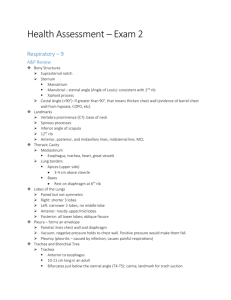Respiratory Assessment
advertisement
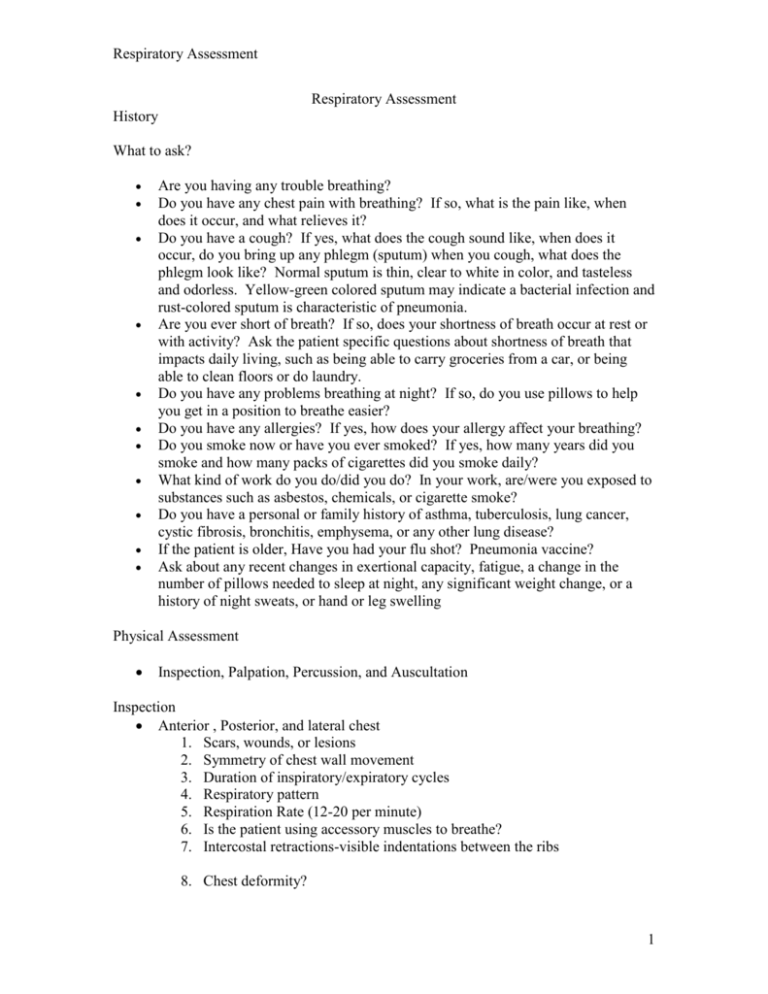
Respiratory Assessment Respiratory Assessment History What to ask? Are you having any trouble breathing? Do you have any chest pain with breathing? If so, what is the pain like, when does it occur, and what relieves it? Do you have a cough? If yes, what does the cough sound like, when does it occur, do you bring up any phlegm (sputum) when you cough, what does the phlegm look like? Normal sputum is thin, clear to white in color, and tasteless and odorless. Yellow-green colored sputum may indicate a bacterial infection and rust-colored sputum is characteristic of pneumonia. Are you ever short of breath? If so, does your shortness of breath occur at rest or with activity? Ask the patient specific questions about shortness of breath that impacts daily living, such as being able to carry groceries from a car, or being able to clean floors or do laundry. Do you have any problems breathing at night? If so, do you use pillows to help you get in a position to breathe easier? Do you have any allergies? If yes, how does your allergy affect your breathing? Do you smoke now or have you ever smoked? If yes, how many years did you smoke and how many packs of cigarettes did you smoke daily? What kind of work do you do/did you do? In your work, are/were you exposed to substances such as asbestos, chemicals, or cigarette smoke? Do you have a personal or family history of asthma, tuberculosis, lung cancer, cystic fibrosis, bronchitis, emphysema, or any other lung disease? If the patient is older, Have you had your flu shot? Pneumonia vaccine? Ask about any recent changes in exertional capacity, fatigue, a change in the number of pillows needed to sleep at night, any significant weight change, or a history of night sweats, or hand or leg swelling Physical Assessment Inspection, Palpation, Percussion, and Auscultation Inspection Anterior , Posterior, and lateral chest 1. Scars, wounds, or lesions 2. Symmetry of chest wall movement 3. Duration of inspiratory/expiratory cycles 4. Respiratory pattern 5. Respiration Rate (12-20 per minute) 6. Is the patient using accessory muscles to breathe? 7. Intercostal retractions-visible indentations between the ribs 8. Chest deformity? 1 Respiratory Assessment a. Barrel Chest -increased anterior and posterior diameter caused by increased functional residual capacity due to air trapping from small airway collapse. Seen in chronic bronchitis and emphysema patients. b. Kyphosis -deformity in the normal posterior shape of the spine, producing a hump-back appearance -can diminish respiratory capacity c. Scoliosis -lateral curvature of the spine -can diminish respiratory capacity Head and Neck 1. Is nasal flaring present? 2. Pursed-lip breathing? 3. Cyanotic lips or mucosa Fingers -assess for clubbing of the fingers which is a sign of lung disease -found in patients with chronic, hypoxic conditions, chronic lung infections, or malignancies of the lung Palpation Skin temperature changes Skeletal deformity Chest movement symmetry Tenderness Swelling Masses Tactile Fremitus -vibratory tremors that can be felt through the chest by palpation -have the patient say “99” or “moon” -normal near the mainstem bronchi, near the clavicles in the front or between the scapula on the back -the tremors should decrease as you move away downward and outward from these areas -decreased fremitus in areas where it is normal can indicate an airway obstruction, pneumothorax, or emphysema -increased fremitus in areas where it shouldn’t be can indicate pneumonia 2 Respiratory Assessment Percussion Helps to determine whether the underlying tissues are filled with fluid, air, or solid material Work from the top of the chest down, comparing sounds from right to left Resonant Sounds -low-pitched, hollow sounds heard over normal lung tissue Dull or thud-like Sounds -normally heard over dense areas such as the heart or liver -may be heard over lung tissue when fluid or solid tissue replaces air-filled lungs -may occur with pneumonia, pleural effusion, or tumors Hyperresonant Sounds -louder and lower-pitched than resonant sounds -normal in children or very thin adults -may also be heard in over-inflated lungs in patients with COPD or having an asthma attack -a unilateral area of hyperresonance may indicate a pneumothorax Tympanic Sounds -hollow, high drum-like sounds -normally heard over the stomach but abnormal if heard on the chest -may indicate a pneumothorax Auscultation Instruct the client to breathe deeply with the mouth open Listen for one full breath cycle in each location Start with the posterior chest at the scapulae and move downward in a z-type pattern, comparing the left and right sides Normal Breath Sounds Classified as tracheal, bronchial, bronchovesicular, and vesicular Tracheal -heard over the trachea -harsh and sound like air is being blown through a pipe Bronchial -present over the large airways in the anterior chest -loud and high in pitch with a short pause between inspiration and expiration Bronchovesicular -heard in the posterior chest -softer than bronchial sounds Vesicular -soft, blowing or rustling sounds heard normally throughout most of the lung fields 3 Respiratory Assessment Normal findings on auscultation include: Loud, high-pitched bronchial breath sounds over the trachea Medium pitched bronchovesicular sounds over the mainstream bronchi, between the scapulae, and below the clavicles Soft, breezy, low-pitched vesicular breath sounds over most of the peripheral lung fields. Abnormal Lung Sounds Absence of sound or presence of abnormal sound Adventitious breath sounds -refers to extra or additional sounds that are heard over normal breath sounds -characterized as crackles, wheezes, rubs, or stridor Crackles (aka Rales) -caused by fluid in the small airways -may be heard on inspiration or expiration -may indicate infection or inflammation of the small bronchi, bronchioles, and alveoli -crackles that don’t clear after coughing may indicate pulmonary edema seen in CHF or ARDS -defined as fine or course -fine crackles are soft, high-pitched, and very brief-you can simulate this sound by rubbing a strand of hair between your fingers at your ear -coarse crackles are louder, lower in pitch, and last longer than fine crackles- can be described as ripping velcro apart Wheezes (aka Ronchi) -high-pitched wheezes with a shrill or squeaking quality are referred to as sibilant wheezes -sibilant wheezing is the kind seen in asthma attacks or where the airways are narrowed -low-pitched wheezes with a snoring or moaning quality are referred to as sonorous wheezes -sonorous wheezing is the kind seen when secretions are present in large airways- can indicate bronchitis and may be cleared with coughing Pleural Friction Rubs -low-pitched, grating, or creaking sounds that occur when inflamed pleural spaces rub together during respiration -easy to confuse with a pericardial friction rub so ask the patient to hold their breath, if you still hear it than it’s a pericardial friction rub because 4 Respiratory Assessment the inflamed pericardial layers continue rubbing with each heartbeat-a pleural rub stops when breathing stops Stridor -high-pitched harsh sound during inspiration -caused by obstruction of the upper airway -sign of acute respiratory distress and must be treated immediately If adventitious sounds are heard, it is important to assess: their loudness, timing in the respiratory cycle, location on the chest wall, persistence of the pattern from breath to breath, and whether or not the sounds clear after a cough or a few deep breaths. o secretions from bronchitis may cause wheezes, (or rhonchi), that clear with coughing 5
